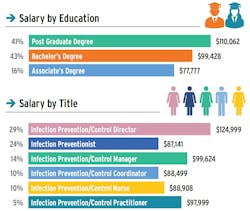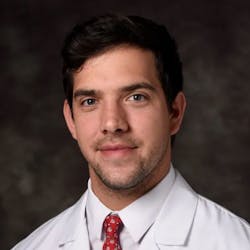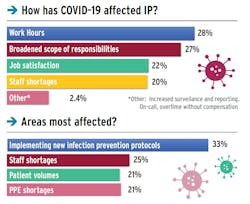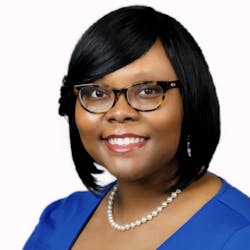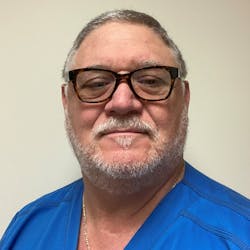Infection Prevention Post-Pandemic: The 2023 IP Salary Survey
Professional recognition in healthcare can be a double-edged sword. The pandemic shined a light on infection preventionists (IP) because of their critical role in protecting patients and staff and stemming the spread of SARS-CoV-2. Many IPs report having taken on added responsibilities with roles expanding beyond the acute-care setting. Like many other professions in healthcare, IP too has been burdened by staffing shortages with too many IPs quitting or retiring and not enough entering the field to make up for the loss.
The results of the 2023 Healthcare Purchasing News Infection Prevention Salary Survey reveal that IPs are still doing more with fewer resources. The question becomes – do they feel as though they are being adequately compensated? How does their level of work compare to the financial rewards?
To provide real-world perspectives alongside the quantitative research, U.S. IPs offered their comments and experiences.
Most report pay raises, job security remains high
The average base salary across all IP positions in 2023 is $101,695, up from $95,000 last year. When looking back to 2020, the average salary has increased by $15,643 (up from $86,052). When asked whether their current annual base salary in 2023 represents an increase over 2022, 70% of survey respondents said “yes.” The percentage of those expecting a bonus this year dropped slightly since last year, at 17% down from 20% in 2022.
The responses on job security were on par with last year’s results, with 52% of IPs surveyed stating they feel “very secure” in their current position, 36% “somewhat secure,” 9% “somewhat insecure,” and 3% “very insecure.”
When looking at reported average annual base salary by title, all titles reported increases except for Infection Prevention/Control Coordinator, where the average salary dropped by $5,370 ($93,869 in 2022 down to $88,499 in 2023.)
The biggest pay jump was reported by Infection Prevention/Control Nurses, with an average increase of $17,123 ($71,785 in 2022 up to $88,908 in 2023). When looking at the average annual reported salary for this position two years ago, in 2021, it was reported to be $80,037; therefore, the large jump might be more related to the specific individuals who took the survey this year rather than the salary for this title in general.
“For the education and licensing required, I believe the IP field is underpaid,” said Bethany Phillips, MPH, CIC, MLS, director of Infection Prevention and Control, Children’s Health in Dallas. “Especially considering the increase in regulatory requirements that fall on the IP teams among other things such as epidemics, increases in HAIs nationwide, increase in vaccine preventable infections, and drug resistant organisms. I think the benefits are good at my facility.”
Once again, location and education count in IP compensation
As in past years, the Pacific region of the U.S. had the highest IP average annual salary at $145,500 in 2023, followed by the Mountain states at $101,245, the Northeast at $96,200, Central states at $95,620 and Southeast $91,235.
With regards to demographics, IPs working in urban areas reported the highest salaries at an average of $110,985, followed by those in the suburbs at $105,980 and rural areas at $83,256.
IPs working in IDN/VHA/Alliance/Multi-group health systems reported the highest average annual compensation at $117,229. Next were IPs in surgi-centers/ambulatory centers at $99,667, followed closely by behavioral/psychiatric health facilities at $98,500. IPs employed by long-term acute care facilities (LTAC) reported an average annual salary of $94,667, neck and neck with those in standalone hospitals at $94,656, followed by IPs in critical access hospitals at $80,000.
IPs employed by for-profit organizations reported the highest annual average salary at $129,190, followed by non-profit organizations at $113,989 and government owned facilities at $99,273.
As in past years, IPs holding post graduate degrees reported the highest pay, at an average of $110,062 annually, followed by those with bachelor’s degrees at $99,428, and associate degrees at $77,777.
IP remains a female, nurse dominated profession, but changes on the horizon
The majority of survey respondents are female (90%), 66% are aged 51 or older and 65% are registered nurses (RN). This aligns with the findings of the Association for Professionals in Infection Control and Epidemiology (APIC) “megasurvey” conducted with APIC members prior to the pandemic, according to APIC President Patricia Metcalf Jackson, RN, MA, BSN, CIC, FAPIC.
“We know we need to attract and retain the next generation for us to survive as a profession,” Jackson added. “And the next generation is not the same. They have different ideals, different values, and different things they want to achieve.”
Jackson noted how APIC is working on several initiatives to attract people from diverse backgrounds into the IP profession, including an academic pathway to IP, an accelerated internship program guide for employers to rapidly onboard IPs, and content for both an undergraduate degree and master’s degree in IP.
“When IP was first designated a profession in the 1970s, it was nurses who did the job,” Jackson commented. “In fact, they were called ‘Infection Control Nurses.’ But today, we know there are lots of other degreed people who could do the job very well, such as those with master’s degrees in public health, laboratory professionals, and others.”
The HPN IP Salary Survey results revealed a drop in RN respondents compared with last year, at 65% in 2023, down from 76% in 2022. When asked if they had licensure or experience in other categories, 12% said they were medical technologists, 9% epidemiologists, 7% educators, 3% LVN/LPN/nurse practitioners, with fewer than 1% of those surveyed reporting to be laboratory technicians or legal nurses.
Those offering write in comments on their background reported experience in cell and molecular biology, endoscopy, veterinary and dental. One respondent said they were working toward a master’s degrees in public health (MPH).
“For new IPs, a more standardized pathway needs to be developed on how to access the field and learn the required skills to function as a proficient IP. This pathway can be created at a facility/system level or at an even earlier level at college and universities. Earlier exposure to the field will create more interest and draw for the profession and fill the needs with ever expanding tasks and duties. The field has a bright future with the pathways into IP expanding and the opportunities once with the field growing. With the increased spotlight on the field, I am hopeful that there will be a draw for new generation of IPs.”
“If you ask most people my age, nobody found this profession purposely,” said Jackson. “They didn’t go to school for it. They just fell into it. One of our goals at APIC is to make it a purposeful profession to find.”
Pandemic pains continue
When asked in what ways COVID-19 has impacted their profession, the most affected areas identified by those surveyed were: implementing infection prevention protocols at 33% (down from 88% in 2022), staff shortages at 25% (down from 66% in 2022), patient volumes at 21% (down from 70% in 2022), and PPE shortages at 21% (down from 62% in 2022).
Although staff shortages appear to be a diminishing concern according to the survey data, those IPs interviewed for this article tell a different story, indicating how shortages continue to fuel burnout rates.
“Burnout is huge,” said Jackson. “I have been an IP for 29 years and the past three years have been 1,000 times more stressful than any other time in my career. IPs have left the field because of it, so we are working on programs to help our members cope. And we are working on retaining IPs through mentorship programs. We are looking at leaders and departments that have had great success in finding people and retaining them to determine what are they doing differently, and then sharing those resources among our members.”
IP roles and responsibilities continue to expand, even beyond the hospital
During the pandemic, many IPs were asked to take on additional responsibilities outside of their regular job duties. The survey results show that continues today. Most respondents (71%) said they continue to perform roles and tasks for which they were not responsible prior to the pandemic.
The pandemic has highlighted the critical importance of IP in preventing and controlling the transmission of infection,” said Hsieh-Li. “Today, the world considers IP synonymous with patient and staff safety. From ensuring data metrics, IP has had to adapt to new pathogens, evolving guidance, and ensure operationalization in their setting. Additionally, IP has had to take full responsibility for PPE inventory, dispensing and accountability for appropriate use at the bedside. This also meant that the IP had to be business-savvy in terms of cost containment and not merely clinically- competent.”
“IPs are experts whose guidance is sought by a plethora of stakeholders throughout their facility therefore it can become a daunting task to ensure IP needs are met within an organization,” said Howard. “Many IPs collaborate with various stakeholders on initiatives across the care continuum that may extend beyond their daily tasks. At times, this may require working longer hours or bringing work home to ensure that timelines are met, and that the organization is adequately supported by IP.”
Infection prevention efforts in their organizations’ non-acute care settings (e.g., physician offices, clinics, long-term care, etc.) were high on the list, with 86% of those surveyed indicating they had responsibility in this area (up from 82% in 2022). Additionally, the write-in comments from survey participants show that many play a role in employee health.
“During the pandemic, IPs functioned in roles not traditionally assigned to the profession and now at the tail end of the pandemic those duties have continued,” said Predic. “Re-assignment will help IPs return to critical tasks along with empowering staff to function in roles similar to theirs prior to the pandemic.”
Phillips commented on some of the new responsibilities that have fallen on IPs: “increased regulatory focus on manufacturers’ instructions for use (IFU), supply shortage issues, increases in sterilization and high-level disinfection (HLD) requirements, and increased environmental issues (example, fungal).”
To compensate IPs for this added work, she calls on employers to provide: “increased salaries that reflect how the demands of the job and cost of living increases, increased support for environmental and construction related specialty areas, and increased support for managing regulatory hot topics such as IFUs.”
While IPs are being asked to do more, Pennington noted how most people outside of the profession don’t realize the extent of responsibilities and work related to infection prevention, stating:
“They have never had to put themselves in our work environment where we deal with patients, family members, physicians, nurses, EVS staff and facility staff. They are not aware of all the regulatory bodies and regulations that we must keep up to date on and apply to protect everyone in the facility.”
The U.S. Department of Labor doesn’t even recognize Infection Preventionist as a job code, despite the fact the field got its start in the 1970s.
“They don’t know we exist,” Jackson commented. “APIC is working on a multi-faceted approach to recruiting and retaining new infection preventionists. We need the U.S. Government to recognize the profession in its official codes so that it will be included in career interest inventories. We are working to develop customized and appropriate academic programs that provide a direct pathway into the field. And, finally, recognizing that there must be varied approaches to accessing training and education, we are working to develop an Occupational Framework and internship model for the field.”
The future of the IP profession
Each year, the Healthcare Purchasing News Infection Prevention Salary Survey provides a snapshot on the current state of the profession. The survey results document changes in compensation, new challenges and opportunities for IPs, and general trends impacting their work. When asked what the IP profession will look like in the future, some of those interviewed offered their thoughts.
“The IP profession will continue to change and adapt to suit both the increasing patient safety needs along with regulatory compliance and reporting needs,” said Predic. “To support this growing need for current IPs a focus needs to be placed on dedicated time for learning and resources to learn new skills.”
“The role of IP is changing – we are not just healthcare people anymore,” said Jackson. “When I started in this profession nearly 30 years ago, IPs were just in acute care hospitals. We are so much more now. IPs are working in long term care hospitals, nursing homes, schools, companies, on cruise ships, and as consultants to the entertainment industry.”
“One area of healthcare that is ushering in significant changes and where IPs must serve as thought leaders is the hospital at home,” Jackson added. “How do we prevent infections in the home environment? How do we perform surveillance for infections in the home environment? Infection Preventionists are experts in healthcare associated infections and we want to be a part of the discussion to provide the safest environment possible for these patients.”
About the Author
Kara Nadeau
Senior Contributing Editor
Kara Nadeau is Sterile Processing Editor for Healthcare Purchasing News.




